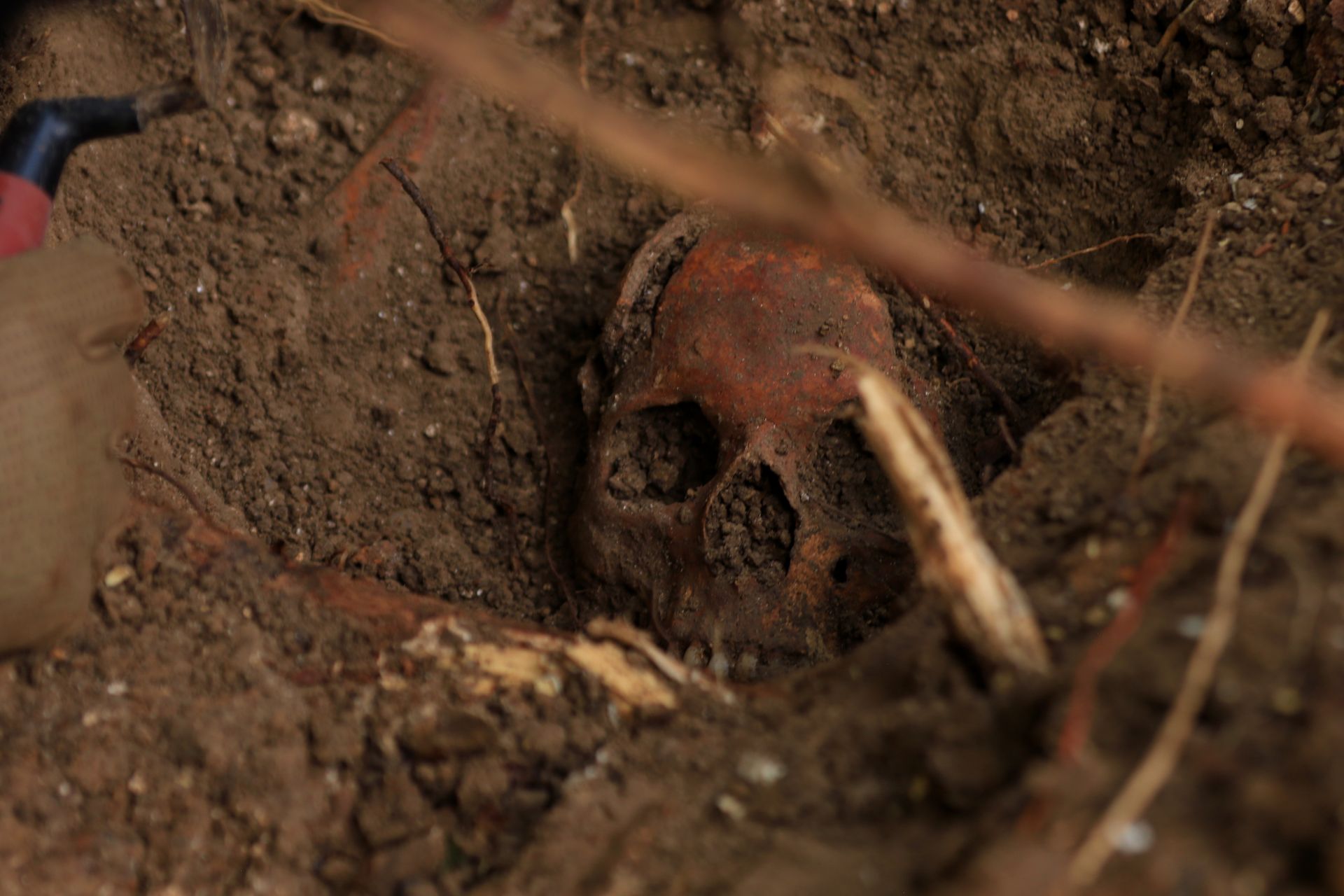When he was finally able to make out the shape of the skull in the dark soil at his feet, Maciej Dancewicz felt the weight of his family’s past bearing down on his shoulders.
“I saw the murdered person about whom I had heard,” Dancewicz told New Lines, speaking metaphorically about the suffering of his ancestors that he perceived in the skull’s haunting features. “I saw her teeth — a smile that will never be.”
In August, Dancewicz, a 49-year-old Polish historian, documentary filmmaker and actor, was standing on top of a mass grave filled with potentially dozens of murdered Polish civilians — some of whom were likely his kin. His grandmother’s aunt was killed in the area, as were other members of his extended family, in massacres of up to 90 Poles that culminated on the night of Feb. 12 and in the early hours of Feb. 13, 1945. Tucked away in an overgrown forest surrounded by dirt roads and freshly harvested fields, the cemetery of the now-abandoned village of Puzniki where the grave is located contains several tombstones with his last name on them. Although Puzniki had been almost entirely ethnically Polish before World War II and lay within Poland’s borders at the time, today its remains stand in western Ukraine, in its Ternopil region.
Dancewicz, who serves as the vice president of the Freedom and Democracy Foundation, the Polish nongovernmental organization spearheading the search effort, has been visiting Puzniki since 2007. Throughout his life, his family had always spoken about the village as if it still existed, holding on to their ancestral memories by anchoring them to the present. So when he was finally given permission by Ukraine to carry out the search for the mass grave late last year, he didn’t spare another moment before amassing a Polish-Ukrainian team.
On and off for the past four months, they have relied on testimony from still-living witnesses and photos of the area taken by German WWII pilots in 1944 to get a sense of where to look. But it wasn’t until late this summer, on Aug. 23, that Dancewicz’s team finally made their discovery. According to one of the archaeologists on site, the young girl’s skull they found was located in a single grave along with several other skeletons and was cracked in a way that suggested extreme head trauma before burial — thus all but confirming that they had found what they were looking for.
Combing through the earth using both a mechanical excavator and the raw power of human muscle, the team had already uncovered several regular, deeply dug, individual grave sites from the prewar or wartime periods. So when they came across the bone of an arm only a couple feet below the surface, in a part of the cemetery they hadn’t explored yet, their interest was piqued. Although no one dared to jump to any conclusions, cautious optimism filled the late summer air. Soon after, when several team members found the first skull fragments, it became clear that this body had been buried haphazardly, with the arm bent at an odd angle. They then found remains from another skeleton in the same burial pit. And then from another. Dancewicz supervised, occasionally taking turns to brush away the dirt while inspecting the remains. Sometimes the tension building around them was too much; some of the archaeologists gathered along the edge of the pit to light cigarettes as they waited for what could be their big break.
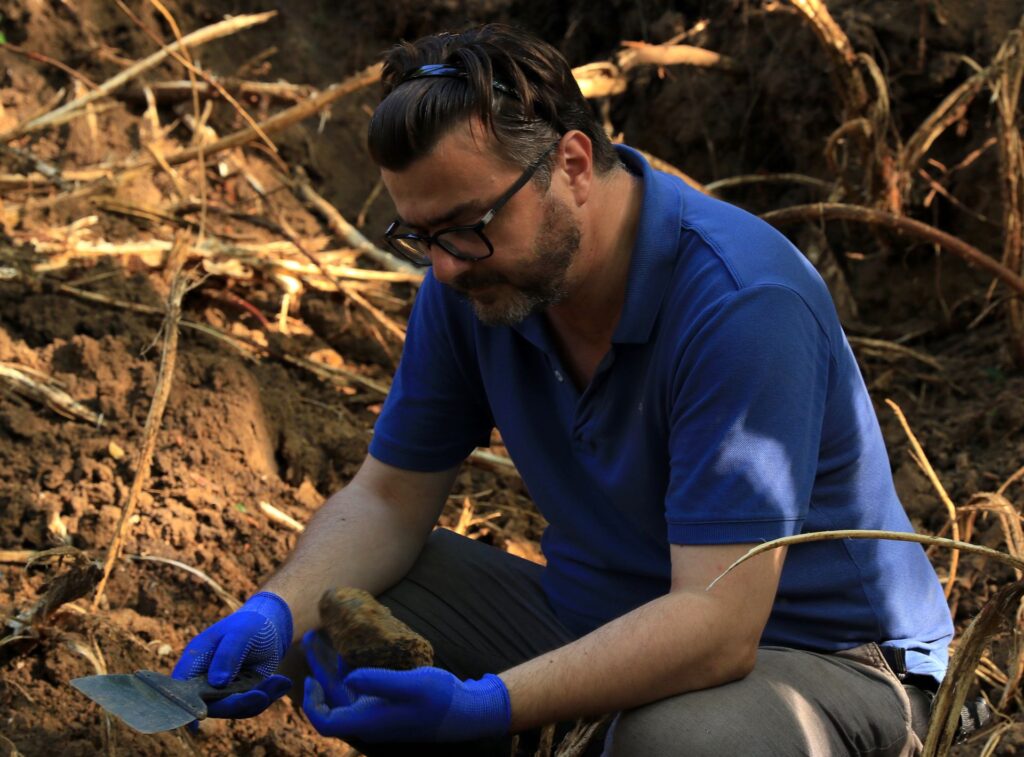
Dancewicz’s team have found five separate skulls so far in this single grave, which they have documented with photos, in 3D scans and in their scientific report of the find. They won’t know the total number of individuals buried in the grave until they receive additional permission to fully exhume the site. Nevertheless, these discoveries alone led one of the archaeologists to declare that the team was “home.”
“You both want to cry and to be happy that we’ve found this grave,” said Adam Baraniecki, the co-founder of an association of former Puzniki residents with roots in the village who was also part of the team. “It’s a moving moment.”
But the find is laden with controversy and entwined with the politics of memory. For the Poles, uncovering the dead is a moment for closure — but those in western Ukraine are wary of the disunity that conversations about such efforts may create with one of their closest allies in their fight against Russia.
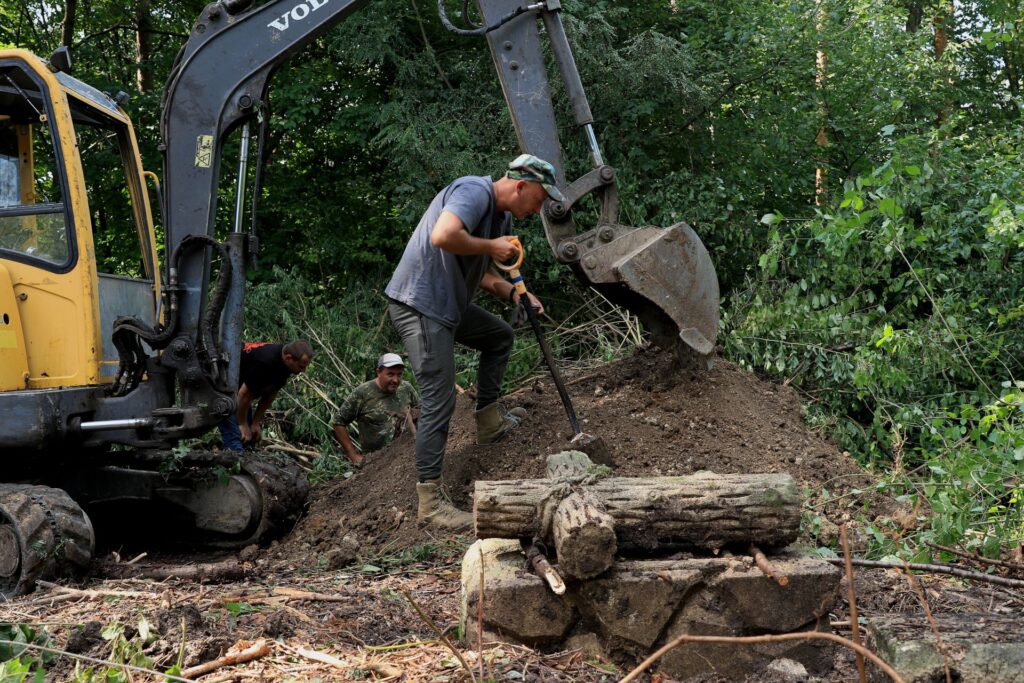
Because of the political sensitivity of their finds, Dancewicz’s team asked New Lines to hold the publication of this article until their talks with the Ukrainian government to obtain a final excavation permit had reached their final phase. On Oct. 27, Polish Prime Minister Mateusz Morawiecki officially confirmed the find in Puzniki in a video posted on X, the platform previously known as Twitter, vowing to continue the fight to exhume and rebury all Polish victims who were killed during the massacres. “This is the first such discovery in many years,” Morawiecki said, stating that most of the victims were women and children. “This crime must be called by its name,” he continued, speaking about the Volhynia massacres as a whole. “This is terrible, brutal genocide.“
According to eyewitnesses and Polish scholars, the perpetrators of the massacre were militants from the Ukrainian Insurgent Army (UPA) and its parent organization, the Organization of Ukrainian Nationalists (OUN), groups that are revered by many modern Ukrainians for their fight for Ukraine’s freedom from Soviet rule. Evidence suggests that the events in Puzniki were one of the last chapters in a wave of killings by Ukrainian militants known as the Volhynia massacres, widely acknowledged as a campaign of ethnic cleansing, which took place from 1943 to 1945 and resulted in the deaths of up to 100,000 Poles who once lived in what is now western Ukraine. The discovery is a significant milestone in the quest to uncover and preserve the historical memory of the Volhynia massacres in the region — an effort that began with the first exhumations related to the period shortly after the fall of the Soviet Union over 30 years ago. It is the first find related to the massacres in eight years and the first to have taken place under the shadow of Russia’s ongoing war.
As a product of the unprecedented solidarity with Ukraine that swept Poland following Moscow’s full-scale invasion last year, the reopening of the grave in Puzniki represents a moment that Poland hopes will lead Ukrainian officials to satisfy Poland’s demand that all its victims be exhumed and properly reburied — a goal that the Ukrainian government, in March, signaled it is willing to work toward. According to Poland’s Institute of National Remembrance, 55,000 ethnic Poles and 10,000 Jews remain buried in mass graves in the region. But although local western Ukrainian leaders have been largely sympathetic to efforts to exhume Poland’s dead, they remain reluctant to confront the historical baggage that will likely come with them.
The massacres took place during a bitter and complicated time in Central and Eastern Europe. The lands in today’s western Ukraine, which prior to the start of WWII in 1939 were part of Poland, were the site of steadily escalating tensions between Polish authorities and the largely second-class Ukrainian population in the turbulent interwar period. During the war, these territories first fell victim to the Soviets in 1939, before the Nazis replaced them in 1941. Men across the region were either deported by the Soviets to Siberia or sent to Germany for work, leaving mostly women, children and the elderly in villages like Puzniki.
Within this crucible of violence and repression, ethnic hatreds reached a boiling point, and Ukrainian nationalist forces decided to take matters into their own hands. In the ensuing mayhem, although UPA and other Ukrainian partisan forces were the primary perpetrators (according to most international scholarship), units of the German army took part in the killings as well in some instances, and Polish paramilitary forces also killed Ukrainians in retaliation for the UPA’s massacres — although the number of these victims was only a small fraction of the number of Poles killed. Ethnic Ukrainians who opposed the Ukrainian militias were often murdered as well.
Before Russia’s invasion last year and the preceding military buildup around Ukraine, the delicate politics around the Volhynia massacres had played a defining role in Poland and Ukraine’s relationship. Following several exhumations of Polish graves from the period between the early 1990s and 2015, the Ukrainian government of former President Petro Poroshenko enacted a ban on subsequent efforts, following a chill in bilateral ties over issues of historical memory.
Under President Volodymyr Zelenskyy, Ukrainian officials have signaled a change of heart, especially after the Russian invasion, granting Dancewicz’s team permission in November 2022 to begin search operations in Puzniki. But obstacles on the road to further exhumations subsequently appeared. Earlier this year, the head of Ukraine’s Institute of National Memory, a government body tasked with preserving Ukrainian historical memory, stated that no new exhumations would be allowed to move forward in Ukraine until Poland made changes to monuments memorializing Ukrainian partisans on its own territory.
But in August, Polish officials stated that they viewed Ukraine’s willingness to permit the search operations in Puzniki as a sign that the previous ban on such operations had in practice been lifted. Working during a time of war, Dancewicz and his partners have had to operate within an elevated security environment and within a more sensitive information space than before, being careful not to play into Russian propaganda efforts to divide Poland and Ukraine.
Oleksiy Zlatohorsky, the lead Ukrainian archaeologist on the team, acknowledged the logistical challenges the war has posed to the search efforts. Standing in the Puzniki cemetery after a hard day’s work, Zlatohorsky, who has been involved in other exhumation projects connected to the Volhynia massacres for over a decade, said his work on the massacres has given him clarity on the crimes committed during that brutal period.
“I’m not a fanatic about UPA. For me this is not all right,” Zlatohorsky said. “I’ve seen these graves, and these children, and these civilians who were killed in these often uncivilized ways.”
“But,” he added, “I’m a scholar, not a politician.”
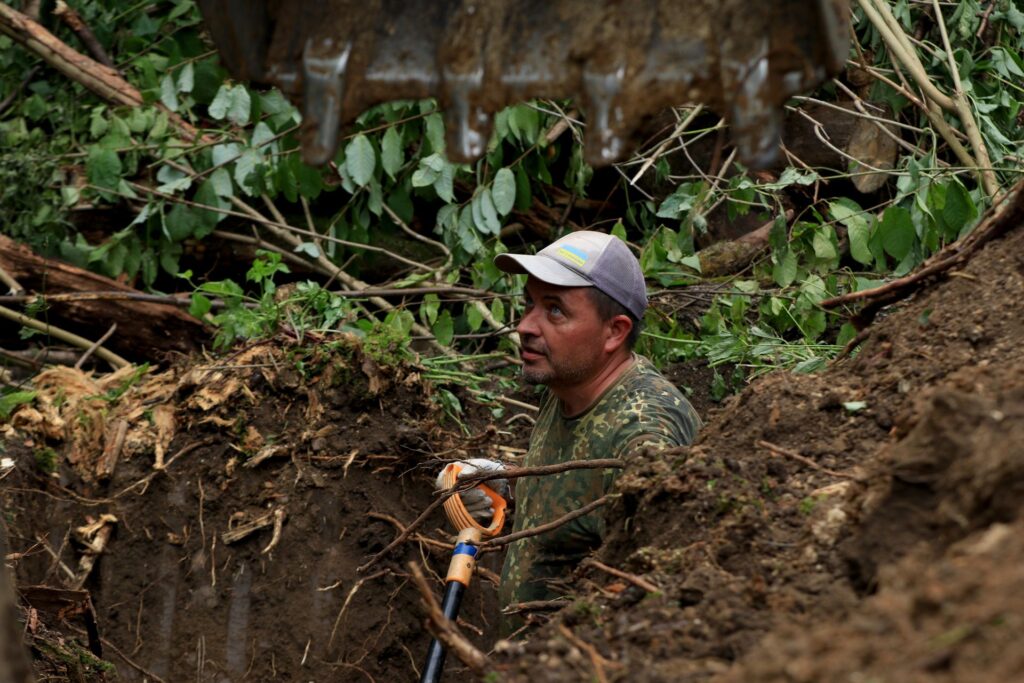
In the nearby municipality of Koropets, just south of Puzniki near the picturesque Dniester River canyon, evidence of the area’s Polish heritage abounds. A crumbling yet lavish palace standing on the edge of town was built here by a Polish noble in 1906, and a Roman Catholic church whose original iteration was consecrated by a medieval Polish king sits near its center. The town has continued to cultivate ties to Poland in the modern period and, after the Russian invasion, Koropets received critical assistance from the Polish village of Iwkowa, with which it had signed a memorandum of cooperation.
Even though it lies far from the active conflict zone, Koropets too has felt the horrors of the present war. Sitting in an empty music school, the head of the town, Mykola Tymkiv, spoke tearfully about five young men from the town who had been killed fighting in the Donbas region in eastern Ukraine. During our interview, the town’s air raid siren went off, an additional reminder of the conflict’s long reach.
“There were absolutely no objections, and people approached this with understanding,” Tymkiv said about the search operations in Puzniki. He described how, prior to WWII, Poles, Ukrainians and Jews lived in harmony in the area, with mixed Polish-Ukrainian marriages being common.
But when it comes to the responsibility for the massacre itself, he has his doubts about the narrative about the UPA.
“They say that Ukrainians did this,” Tymkiv said. “My ancestors said this was a lie and that the [Russians] did this to divide Poles and Ukrainians.”
Tymkiv’s perspective, which is common in western Ukraine, is far from surprising given the contentious nature of the issue, according to Yuri Shapoval, a Ukrainian professor at the Kuras Institute of Political and Ethnonational Studies at the National Academy of Sciences of Ukraine in Kyiv, who previously co-chaired the Polish-Ukrainian Historical Forum.
“Disputes about the past have always been and remain a function of modernity,” Shapoval said, noting that while much has been written about the killing of Poles by Ukrainian nationalist forces, much still remains for historians to unravel on the issue. “Not everything was simple and clear in that terrible Volhynia amalgam.”
At Huta Penyatska, another site of anti-Polish massacres in western Ukraine, locals have been trying to make efforts to bridge such disputes not by focusing on history but rather on what unites Poles and Ukrainians today. In 2013, Father Yaroslav Bordyukh, who heads several congregations in and around the nearby village of Holubytsya, presented members of the Association of Huta Pieniacka, as it is spelled in Polish, with the monstrance — the golden vessel used by the Catholic Church to carry the sacramental bread — from the church that once stood in the village.
“God’s love can reign between us,” Bordyukh said as he sat inside the ornately decorated Greek Catholic Church of the Nativity of the Holy Mother of God in Holubytsya on a hot August afternoon. “I think this monstrance was the first sign that we desire this real love. We came out and did an act of goodwill.”
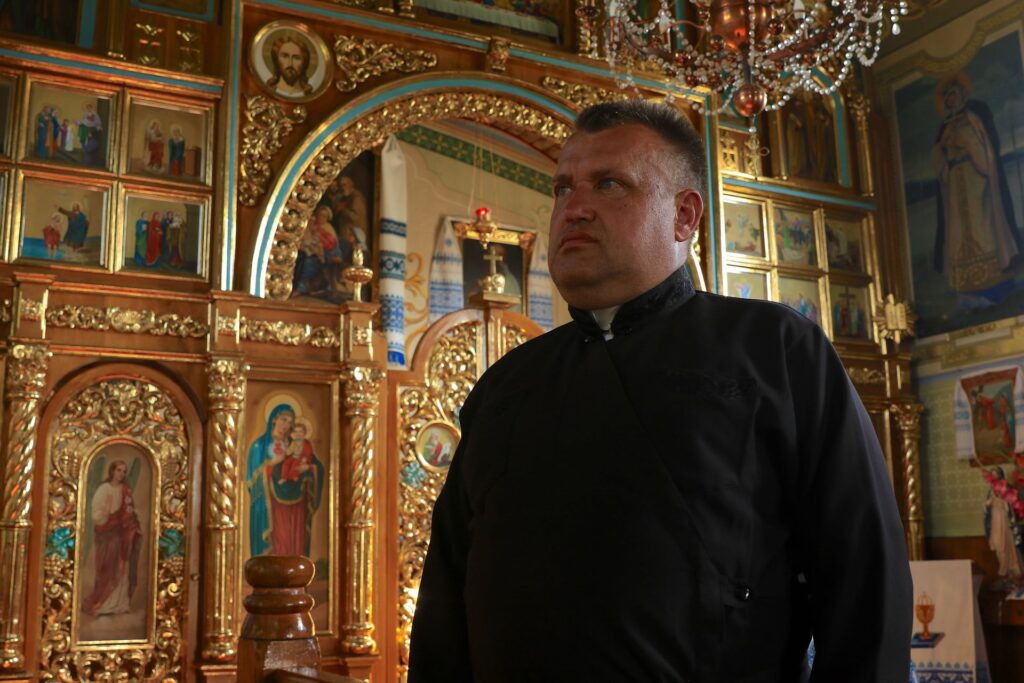
Today, Bordyukh helps distribute medicine, goods and clothing either from abroad or from local communities to soldiers on the front in eastern Ukraine. He recalls how, on one occasion, he even passed on a shipment of ammunition donated to the Ukrainian military by a Polish hunting association.
While Bordyukh said he is all in favor of giving the victims of the Volhynia massacres a proper Christian burial, he believes the only way forward is to ultimately leave the past behind.
“Putin has shown us that without unity there won’t be anything,” he said, mentioning the numerous Polish volunteers fighting for the Ukrainian side in the east as proof of the power of Polish-Ukrainian cooperation. “If we disunite over such a small issue, then this issue will grow. It would be enough to close this and forget it.”
But for many Poles, and especially for survivors of the massacres and their families, forgetting isn’t an option, and neither is equivocating about which groups were responsible. Kazimierz Czagowiec was born in Lutsk, the capital of what is today Volhynia Oblast, in 1942, just before the massacres erupted at peak strength in the region. His father hid his family in the woods outside of the city alongside other Poles, but they soon had to flee again after they heard that Ukrainian militias would kill everyone hiding in the area.
Although Czagowiec was too young to remember these events, he has carried the knowledge of them with him his whole life and, in his retirement, has helped to collect accounts and documents about the massacres as part of memory projects in Poland.
“I know how it was — these were horrible things, absolutely horrible,” he told me, sitting in his Warsaw apartment. Czagowiec’s bedroom study contains piles upon piles of books, leaflets and printouts related to the massacres, and he has put together a document describing his own family’s experiences in western Ukraine. It includes tender photographs of his parents’ lives in Lutsk in the interwar years, along with a photo of him as a toddler feeding chickens during the war.
“Today people have descended into a difficult forgetfulness,” Czagowiec lamented. “You cannot forget.”
Yet Czagowiec holds no grudges against Ukrainians. He said that since Ukrainian refugees arrived in Poland starting last year, he has built friendships with them, and deeply values the contributions these refugees have made to Polish society, especially in the labor force and in Poland’s intellectual life. In addition, he has always remembered that his family was only able to escape death thanks to a tipoff from a Ukrainian acquaintance who warned his father to flee before it was too late.
“One way or another, we need to reconcile,” he said. “[Poles] need Ukrainians like we need water.”
Not all Poles see it that way, however. In the days surrounding the 80th anniversary of the start of the massacres in July, far-right movements staged protests in several major cities in Poland including Warsaw, describing Ukraine as an enemy and warning of a Polish-Ukrainian conflict on Polish soil, sentiments that are not supported by the majority of Poles.
“Both here and [in Poland] there are some radicals, we can call them nationalists,” said Tymkiv, saying their presence can have a damaging effect on Poland and Ukraine’s ability to reconcile their dueling versions of the history of the Volhynia massacres. “They have existed, and they will continue to exist.”
Before the war, extremists also took part in provocative actions in Ukraine, vandalizing memorials to Polish victims at Huta Penyatska and nearby Pidkamin in 2017 and desecrating them with anti-Polish messages.
However, in today’s context of the Russian invasion, such fringe outbursts seem like distant history, and the head of the Pidkamin town government, Bohdan Butyntskyi, was quick to denounce them and distance local communities from them. Yet he said that the way the Polish government has gone about trying to resolve the issue has left a bad taste in his mouth.
“When the representative of the president of Poland comes and straight away begins talking about how Ukrainians killed Poles, on our territory, it’s a bit incorrect,” Butyntskyi said, dressed in a traditional Ukrainian embroidered shirt, or vyshyvanka, for Independence Day celebrations in Pidkamin.
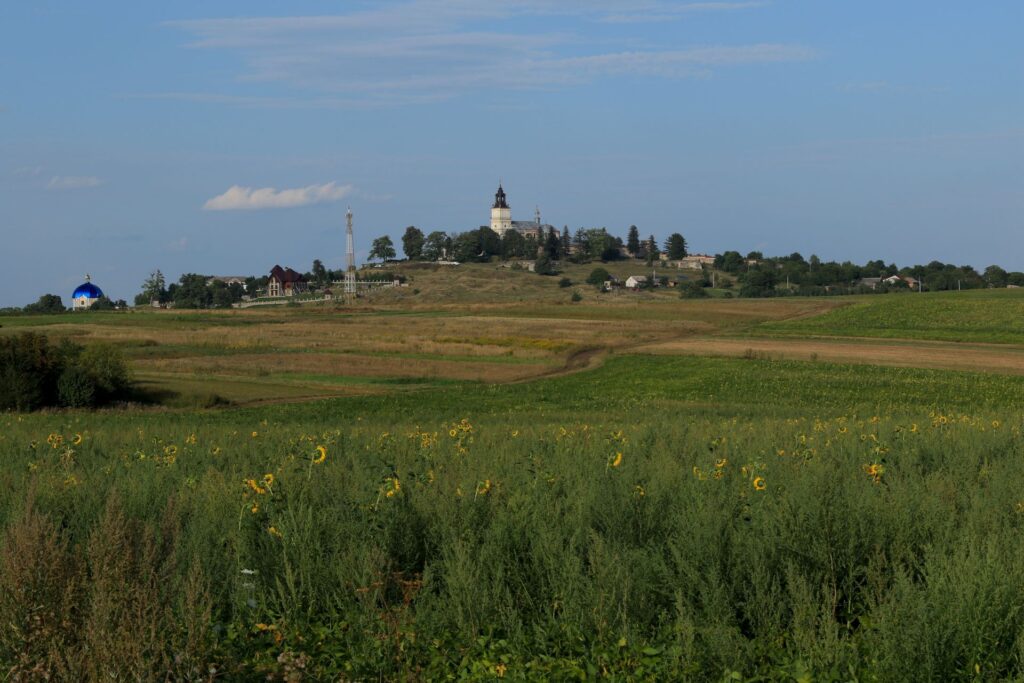
But in spite of political sensitivities around the issue, especially during wartime, time is of the essence for Dancewicz, whose sole mission is to move the exhumation process forward.
“I won’t wait until the last living witness dies with the knowledge that they didn’t do anything to find their mother,” he said.
Despite the importance of the finds at Puzniki, Polish archaeologists have their work cut out for them. According to Damian Markowski, a Polish historian at the Jan Karski Institute of War Losses, in Warsaw, more than 600 sites exist throughout western Ukraine in which victims of the Volhynia massacres are buried.
“From what I know, search efforts have taken place at several dozen locations, and in six places, they were connected with exhumations,” said Markowski, who has himself been present at one of these exhumations. “So we see the scale of the problem.”
Dancewicz’s team has so far received permission only to locate the remains without removing them, but once they are able to get the necessary permissions to complete the exhumations in Puzniki, Dancewicz and his team have decided they will rebury the victims in the village cemetery near where they lived. Then establishing a memorial will begin, likely to be a lengthy and arduous process.
“We will be fighting over every letter,” Dancewicz predicts.
But with the specter of Russia now hanging over the heads of both Poles and Ukrainians, it isn’t lost on anyone that renewed cooperation on the reburials of Poles in western Ukraine has emerged from a friendship catalyzed by their common enemy in the east.
For Dancewicz, though, the closeness between the two countries goes beyond mere circumstance. However contentious the disputes over the Volhynia history may be, it is only natural for Poland and Ukraine to overcome them.
“For Poles and Ukrainians, our future lies together,” Dancewicz said. “Our catastrophe will be when we are apart.”
Sign up to our mailing list to receive our stories in your inbox.



